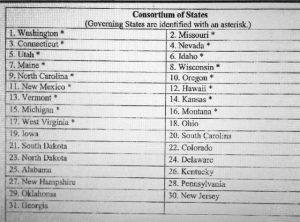Smarter Balanced (SBAC) Race to the Top Application and 15 of Its State MOUs
On July 29, 2015, I posted the 1,609-page Partnership for Assessment of Readiness for College and Career (PARCC) Race to the Top (RTTT) application.
In this post, I offer the 1,294-page Smarter Balanced Assessment Consortium (SBAC) RTTT Application.
Here is an excerpt from the SBAC executive summary (page 4):
Following the principle of “responsible flexibility,” SBAC will provide options for customizable system components while also ensuring comparability of high-stakes summative test results across States. In addition, the Consortium is committed to creating a policy environment that fosters innovation while supporting the development of accountability systems that incentivize the right behaviors for students, teachers, and administrators and avoid inadvertently incentivizing behaviors that run counter to SBAC goals.
If a behavior supports SBAC goals, it is “right.”
If not, it is wrong.
If you stare at that paragraph long enough, you’ll see Skinner offering an approving nod.
Like PARCC, SBAC holds technology in high regard– and assumes it is reliable and readily available:
SBAC’s system capitalizes on the precision and efficiency of computer adaptive testing. …In summary, SBAC’s proposed learning and assessment system is grounded in a sound Theory of Action.
I’m not sure how many hours these “theory grounders” have spent wrangling with obstinate or otherwise state-of-the-art-challenged public school technology– or of considering what (or who) schools and districts will have to cut in order to pump dollars into test-intended technological upgrades.
Test-score-driven behavior modification can be pricey.
The State of Washington is running this SBAC show. See pages 6 and 7 for signatures of WA Governor Christine Gregoire (June 09, 2010), School Chief Randy Dorn (June 10, 2010), and State Board of Ed Chair, Jeff Vincent (June 15, 2010). The same signature page is repeated on page 10.
Page 11 lists the 31 SBAC member states, 17 of which are “governing states” and are marked with asterisks (click image to enlarge):
Below the above list is the note, “Washington State (#1) is a Governing State in addition to serving in the unique role of lead Procurement State/Lead State for the Consortium.”
Notice that California was not on the SBAC membership roster in June 2010. At that time, California was with PARCC and was the first state to leave PARCC in June 2011– and the PARCC profit potential dropped notably with the anticipated loss of at least a few million CA students who would have otherwise taken PARCC.
California joined SBAC in June 2011. SBAC was of course happy about this.
Now, to the memoranda of understanding (MOU’s) included as part of the SBAC Smarter Balanced (SBAC) Race to the Top Application and 15 of Its State MOUs | deutsch29:


